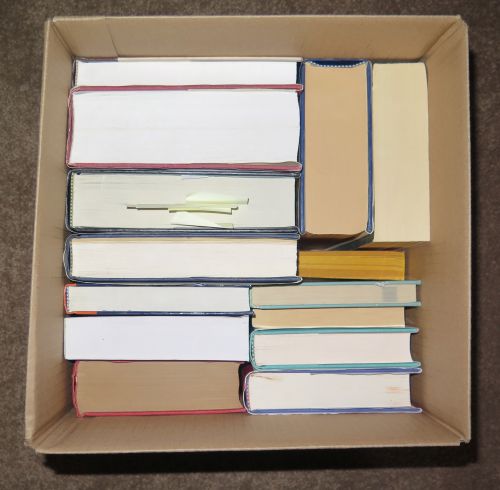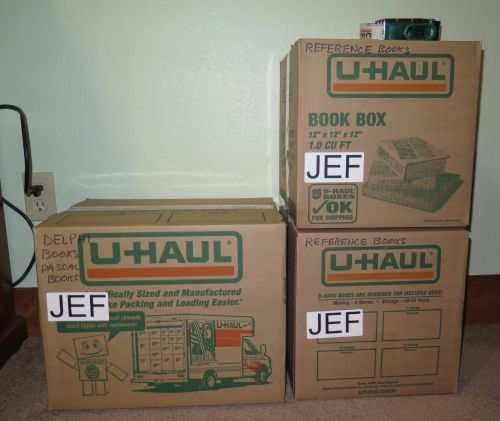
Packing continues apace. I consistently get 5-8 boxes packed every day, and over time it adds up. I have well over 100 piled around the house by now. A lot of the most difficult stuff has been done, including almost everything in my biggish workshop. Carol and I hoarded cardboard boxes for most of a year before the move, and in fact before we began looking for a place in Arizona. We knew we would have to pack the garage before we emptied it in preparation for replacing the concrete slab. The garage contains a lot of high-density items, most of them metal. Smaller boxes are good for that. Once we decided that the whole house had to be packed, small boxes became even more useful, for tools and Meccano parts and panel meters and much else from my twelve feet of head-high shelves.
We’ve done this before, but we’re doing it more carefully this time. I’ve mentioned the core reason: We’re going from 4400 square feet to 3000 square feet. During the process I’ve been passing judgment on things to be packed, asking myself if this item or that item really needs to follow us to Arizona. Such decision-making is difficult when you have to pile everything in the house into boxes over a single long weekend because a new job awaits you somewhere on the other side of the country. In the past, well, we just piled.
There’s another reason to be careful: Movers emptying a moving van have to put boxes somewhere. Empty bookshelves take up as much space as full bookshelves, and 2200 books take up a lot of space, period. If we intend to be able to move around in the new house once everything gets down there, we need to put as much stuff into as few boxes as possible.
In pursuing that goal, I realized I have a personal super-power: tessellation. I can look at a pile of things beside an empty box, and fairly quickly fill the box so that little dead space remains. (See the photo above.) Mass-market paperbacks are no big challenge, because they’re all nearly the same size and differ mostly in thickness. Hardcovers and trades are trickier. Reference books are all over the map, size-wise, and are the trickiest of all. Spools of wire are tricky too, because if you’re clever you can nest them. I got an amazing amount of wire into a single Borders book box. (I still have a fair number of those from our move 12 years ago.) Tessellating test equipment proved diabolical, but I got a lot more into fewer boxes than I ever have in the past. I got my entire GRC-109 Special Forces radio set into a single 12″ cube, though it’s so heavy I fear for the box’s life. (The radio units themselves are essentially armored and not especially vulnerable to weak forces like gravity.)

I have a labeling system to tell the movers what room to put each box in: I defined a 3-character code for each room in the house (plus the two garages and the shed) and then printed several sheets of Avery 5263 10-up labels for each code. I also have Visio documents for each code that place the code on a single sheet of paper as large as will fit. (The tags above indicate that the boxes are to be stacked in my office.) On moving day we’ll tape those sheets to the entrances of each room in the house so that the movers know which code has been assigned to which room.
So box by box, we crawl ever-closer to moving day. Each time we do this, we tempt the Fates by saying we hope never to do it again. This time I’ll play reverse psychology on the Fates by saying, Yo! Fates! Tessellation Man is ready for whatever you can throw at him!
I wonder if they’re even listening.











BTDT before. We have been hording boxes for about 9 years… who am I kidding, we never fully unpacked 10 years ago. 😀
And I call my special ability “spacial” because I can look at a space and pretty accurately tell you what will fit in that space. Be it a box or a room.
Good luck with the move. Glad it is not me… yet.
Jeff, I learned about books and boxes the hard way when I tried to pack all mine in the biggest box I could find. I don’t think it could have been lifted with a fork lift.
After learning this, one of my favorite boxes for things like magazines and books of about that size was the old dot matrix printer boxes which came full of letter size fan fold with perfs on the edges. Where I worked in the 1980’s there was a section of 8 to 10 people doing heads down data entry on a mainframe system all day and the “backup” system was to print every transaction screen as entered. The empty boxes were free for the taking and take I did.
Your system sounds similar to one we used when we moved offices into a new facility back in the day. Boxes coded by location and location codes taped up where the boxes go. It worked pretty well.
I also have this spatial-visualization gift. I think it’s something that most engineers possess by nature. It used to drive my wife nuts when I’d tell her “that won’t fit in there.” I was mostly right, enough so that it became a game to prove me wrong. 🙂
Good luck on the move!
Great job Jeff. During my 20 year career in the Marine Lisa and I moved at least eight times. So, I know how stressful it is. First time we moved I decided to put all my books in one of those dish-pack boxes. Doh! Live and learn.
That top picture instantly reminded me of a Tk packer example…
Ha! I hadn’t thought of that, but…precisely. When I first encountered Tcl/tk 20-odd years ago, tk and its GUI features were what drew me in, the packer in particular. I did a section on using tk with Python for my (apparently dead in the water) Raspberry Pi architecture book, but we had to pull it out to keep the chapter a manageable size.
Mass-market paperbacks are no big challenge, because they’re all nearly the same size and differ mostly in thickness.
You are almost as old as I. Did you just miss those dear, dead days when mm-paperbacks came in several page sizes? Or have they just all turned to dust?
I mostly missed them. I started getting an allowance in the fall of 1966, and a lot of what I got went to cheap MMPBs. I know of the small MMPBs that were common before then and even had a few, but I think they fell apart and were pitched in the 1980s. I had a few used ones with a 40c cover price, but that was from the early 1960s. When I started it was 60c or 75c. By the time I was in college it was 95c.
Interestingly, there is a new MMPB trim size which is taller but no wider than the conventional MMPB. I think this allows the publishers to print long books without making them excessively thick. Keeping them the same width means that bookstores can still put them face-out on shelves and racks designed for typical MMPBs. I’m sure there’s a word for that trim size but I’ve not found it, nor do I have an example here. Thrillers seem to be the ones found in that size.
I’ve seen those primarily in the “thriller” and “romance” genres. Looking inside, they seem to have slightly larger fonts and more whitespace than normal books.
My impression was that the height was a marketing ploy.
Some years back the Chicago Reader had a cover story titled “The Way He Moves”, about the world’s greatest household goods mover. He had the tesselating gift for moving vans. A loaded van would arrive somewhere, the crew would open the doors, and someone would say “Joe packed this one.”
It wasn’t just density, too: everything was stacked safely and accessibly.
The man had retired from moving several times, but was always drawn back to it: it was what he did best.
When we moved from Baltimore to Scotts Valley in early 1987, the estimator did a crap job of estimating, and they sent out the wrong size truck. The driver called the estimator, the estimator came out, and the two of them got into a screaming match in the middle of the street that I feared would become a fistfight. Faced with 10-15% more stuff than would fit in the truck, the middle-aged African-American gentleman who was the crew foreman scratched his head, had his guys pull some stuff out of the truck, and started the most amazing large-scale tessellation job I have ever seen. It took until 11:00 that night (and this was early March!) but he got it all in, packed so tight you couldn’t stick a squashed cricket between the boxes. Remarkably, nothing was damaged in the move, unlike our move from Scottsdale to Colorado Springs in 2003, when we lost two lamps to clumsy handling.
As for how this works, my best guess is an intuitive ability to envision spatial relationships. I think it helped having had two years of high school drafting plus a semester of engineering graphics (including projective geometry) during my one semester of engineering school. However it works, it’s been damned handy down the years, and I seem to be getting better at it.
One of my greatest losses in moving happened in 2006, when we left Scotts Valley for Georgia. When the truck finally arrived, a plastic crate of magazines was full of water. All my Turbo Technix, PC Techniques, and Visual Developer magazines were in that box.